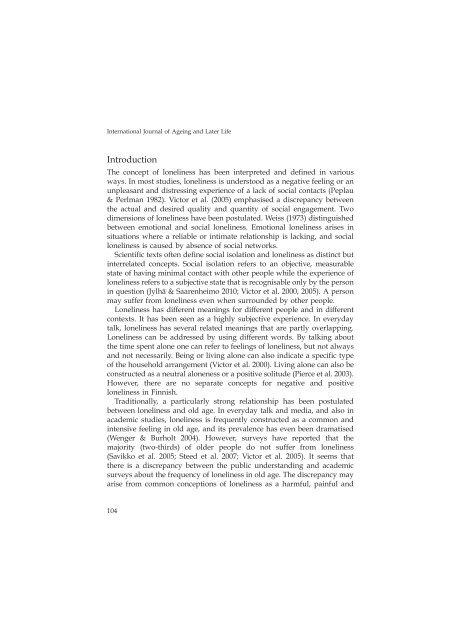Avaa tiedosto - TamPub - Tampereen yliopisto
Avaa tiedosto - TamPub - Tampereen yliopisto
Avaa tiedosto - TamPub - Tampereen yliopisto
Create successful ePaper yourself
Turn your PDF publications into a flip-book with our unique Google optimized e-Paper software.
International Journal of Ageing and Later Life<br />
Introduction<br />
The concept of loneliness has been interpreted and defined in various<br />
ways. In most studies, loneliness is understood as a negative feeling or an<br />
unpleasant and distressing experience of a lack of social contacts (Peplau<br />
& Perlman 1982). Victor et al. (2005) emphasised a discrepancy between<br />
the actual and desired quality and quantity of social engagement. Two<br />
dimensions of loneliness have been postulated. Weiss (1973) distinguished<br />
between emotional and social loneliness. Emotional loneliness arises in<br />
situations where a reliable or intimate relationship is lacking, and social<br />
loneliness is caused by absence of social networks.<br />
Scientific texts often define social isolation and loneliness as distinct but<br />
interrelated concepts. Social isolation refers to an objective, measurable<br />
state of having minimal contact with other people while the experience of<br />
loneliness refers to a subjective state that is recognisable only by the person<br />
in question (Jylhä & Saarenheimo 2010; Victor et al. 2000, 2005). A person<br />
may suffer from loneliness even when surrounded by other people.<br />
Loneliness has different meanings for different people and in different<br />
contexts. It has been seen as a highly subjective experience. In everyday<br />
talk, loneliness has several related meanings that are partly overlapping.<br />
Loneliness can be addressed by using different words. By talking about<br />
the time spent alone one can refer to feelings of loneliness, but not always<br />
and not necessarily. Being or living alone can also indicate a specific type<br />
of the household arrangement (Victor et al. 2000). Living alone can also be<br />
constructed as a neutral aloneness or a positive solitude (Pierce et al. 2003).<br />
However, there are no separate concepts for negative and positive<br />
loneliness in Finnish.<br />
Traditionally, a particularly strong relationship has been postulated<br />
between loneliness and old age. In everyday talk and media, and also in<br />
academic studies, loneliness is frequently constructed as a common and<br />
intensive feeling in old age, and its prevalence has even been dramatised<br />
(Wenger & Burholt 2004). However, surveys have reported that the<br />
majority (two-thirds) of older people do not suffer from loneliness<br />
(Savikko et al. 2005; Steed et al. 2007; Victor et al. 2005). It seems that<br />
there is a discrepancy between the public understanding and academic<br />
surveys about the frequency of loneliness in old age. The discrepancy may<br />
arise from common conceptions of loneliness as a harmful, painful and<br />
104














